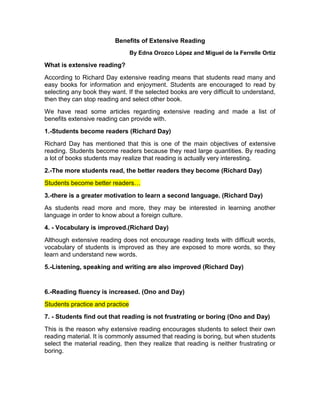
Benefits of extensive reading
- 1. Benefits of Extensive Reading By Edna Orozco López and Miguel de la Ferrelle Ortiz What is extensive reading? According to Richard Day extensive reading means that students read many and easy books for information and enjoyment. Students are encouraged to read by selecting any book they want. If the selected books are very difficult to understand, then they can stop reading and select other book. We have read some articles regarding extensive reading and made a list of benefits extensive reading can provide with. 1.-Students become readers (Richard Day) Richard Day has mentioned that this is one of the main objectives of extensive reading. Students become readers because they read large quantities. By reading a lot of books students may realize that reading is actually very interesting. 2.-The more students read, the better readers they become (Richard Day) Students become better readers… 3.-there is a greater motivation to learn a second language. (Richard Day) As students read more and more, they may be interested in learning another language in order to know about a foreign culture. 4. - Vocabulary is improved.(Richard Day) Although extensive reading does not encourage reading texts with difficult words, vocabulary of students is improved as they are exposed to more words, so they learn and understand new words. 5.-Listening, speaking and writing are also improved (Richard Day) 6.-Reading fluency is increased. (Ono and Day) Students practice and practice 7. - Students find out that reading is not frustrating or boring (Ono and Day) This is the reason why extensive reading encourages students to select their own reading material. It is commonly assumed that reading is boring, but when students select the material reading, then they realize that reading is neither frustrating or boring.
- 2. 8. - Students enjoy reading! (Ono and Day) This is other of the most important benefits and it may be the main purpose of extensive reading. 9. - Students get engaged with reading (Philip Prowse) Students get engaged with reading when they start to enjoy reading. 10. - It is an important source of ideas and information (Dr. Viviene Yu) By reading students can not only find information but ideas. 11. - Reading may be a vehicle for teaching language (Day and Bramford) By reading students can find a variety of vocabulary and grammatical structures in the language they are learning. Students can also learn cultural aspects. 12.- Owing to reading students may discover that reading is a personal interaction with the text. Reading does not only involve dealing with ideas and words, there is also an interaction between the reader and the text.
